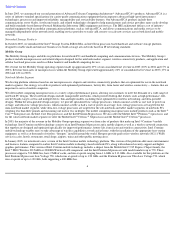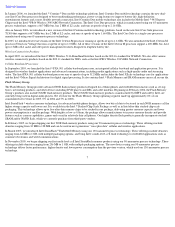Intel 2005 Annual Report Download - page 16
Download and view the complete annual report
Please find page 16 of the 2005 Intel annual report below. You can navigate through the pages in the report by either clicking on the pages listed below, or by using the keyword search tool below to find specific information within the annual report.
Table of Contents
Backlog
We do not believe that a backlog as of any particular date is indicative of future results. Our sales are made primarily pursuant to standard purchase
orders for delivery of standard products. We have some agreements that give a customer the right to purchase a specific number of products during a
specified time period. Although these agreements do not generally obligate the customer to purchase any particular number of such products, some of
these agreements do contain billback clauses. Under these clauses, customers who do not purchase the full volume agreed upon are liable for billback
on previous shipments up to the price appropriate for the quantity actually purchased. As a matter of industry practice, billback clauses are difficult to
enforce. The quantities actually purchased by the customer, as well as the shipment schedules, are frequently revised during the agreement term to
reflect changes in the customer’s needs. In light of industry practice and our experience, we do not believe that such agreements are meaningful for
determining backlog amounts. Only a small portion of our order backlog is non-cancelable, and the dollar amount associated with the non-cancelable
portion is not significant.
Competition
Our products compete primarily on the basis of performance, features, quality, brand recognition, price and availability. Our ability to compete
depends on our ability to provide innovative products and worldwide support for our customers, including providing enhanced performance per watt,
reduced heat output and integrated solutions. In addition to our various computing, networking and communications products, we offer technology
platform solutions that incorporate our various components, which bring together a collection of technologies that we believe create a better end-user
solution than if the ingredients were used separately.
The semiconductor industry is characterized by rapid advances in technology and new product introductions. As unit volumes grow, production
experience is accumulated and costs decrease, further competition develops, and as a result, prices decline. The life cycle of our products is very short,
sometimes less than a year. Our ability to compete depends on our ability to improve our products and processes faster than our competitors, anticipate
changing customer requirements, and develop and launch new products, while reducing our costs. When we believe it is appropriate, we will take
various steps, including introducing new products and platform solutions, discontinuing older products, reducing prices, and offering rebates and other
incentives, to increase acceptance of our latest products and to be competitive within each relevant market segment. Our products compete with
products developed for similar or rival architectures and with products based on the same or rival technology standards. We cannot predict which
competing technology standards will become the prevailing standards in the market segments in which we compete.
Many companies compete with us in the various computing, networking and communications market segments, and are engaged in the same basic
fields of activity, including research and development. Worldwide, these competitors range in size from large established multinational companies
with multiple product lines to smaller companies and new entrants to the marketplace that compete in specialized market segments. In some cases, our
competitors are also our customers and/or suppliers. Product offerings may cross over into multiple product categories, offering us new opportunities
but also resulting in more competitors. In market segments where our competitors have established products and brand recognition, it may be difficult
for us to compete against them.
We believe that our network of manufacturing facilities and assembly and test facilities gives us a competitive advantage. This network enables us to
have more direct control over our processes, quality control, product cost, volume and timing of production, and other factors. These types of facilities
are very expensive, and many of our competitors do not own such facilities, because they cannot afford to do so or because their business models
involve the use of third-party facilities for manufacturing and assembly and test. These “fabless semiconductor companies” include Broadcom
Corporation, NVIDIA Corporation, QUALCOMM Incorporated and VIA Technologies, Inc. (VIA). Some of our competitors own portions of such
facilities through investment or joint-venture arrangements with other companies. There is a group of third-
party manufacturing companies (foundries)
and assembly and test subcontractors that offer their services to companies without owned facilities or companies needing additional capacity. These
foundries and subcontractors may also offer to our competitors intellectual property, design services, and other goods and services. Competitors who
outsource their manufacturing and assembly and test operations can significantly reduce their capital expenditures.
12
























